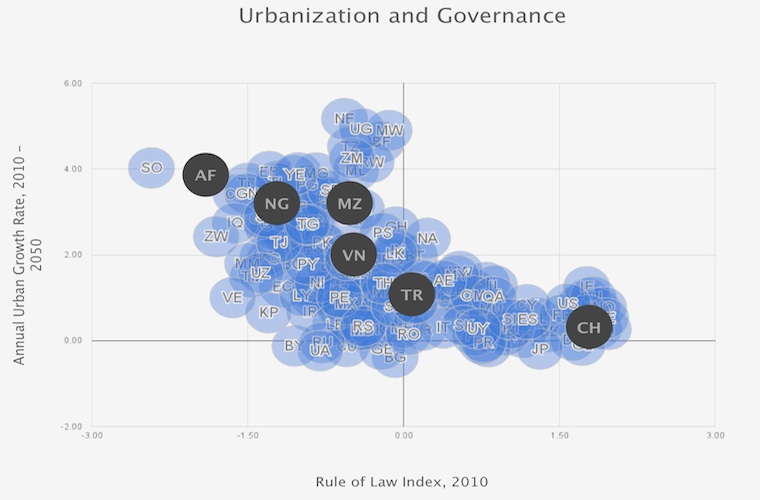Weak Governance and Rapid Urbanization
+ Brandon Fuller
Less developed countries will become increasingly urban this century, often at historically low levels of GDP per capita and historically weak levels of governance. In other words, developing countries are catching up to the rest of the world more quickly on urbanization than on income or institutional development. This key point serves as the basis for Edward Glaeser’s recent NBER working paper, A World of Cities: The Causes and Consequences of Urbanization in Poorer Countries (gated; Richard Florida offers a nice summary here).
Glaeser suggests that globalization helps to explain the ability of developing countries to achieve higher urban population shares at lower levels of income (and weaker rates of economic growth). Historically, countries needed to increase agricultural productivity to a level sufficient to feed the growth of cities. In a world of freer trade, developing countries no longer face this constraint. Because urban dwellers can import food from all over the world, mega-cities in relatively poor countries are no longer so dependent on their hinterlands. As such a country’s agricultural productivity can stagnate (reflected in weaker economic growth rates overall) even as its urban population booms.

On the challenge of rapid urbanization in the face of weak governance, Glaeser sounds a note of concern. Urbanization brings with it a host of negative externalities such as crime, traffic congestion, and contagious disease. Managing these externalities requires effective governance. Without it, Glaeser’s modeling suggests that large cities might resort to more draconian measures to prevent negative externalities—measures that will too often come at the expense of peoples' rights and local quality of life. Think of responding to traffic congestion by forbidding vehicles with certain license plates from driving on certain days, or worse, by clinging to traditional norms that ban women from driving or working in the formal sector. Or think of responding to crime with a blanket curfew.
Despite concerns about weak governance, Glaeser remains optimistic about the role of urbanization in the developing world, noting the robust correlation between urbanization and income growth among poorer countries as well as the tendency for densely populated cities to generate social movements capable of exerting beneficial pressure on government.
I’d add another channel through which cities may be able to speed up their rate of institutional development. As Glaeser points out, a more open world allows people in poor mega-cities to exchange goods and services with the rest of the world. It also allows community groups and innovative urban officials to exchange ideas with cities all over the world. There is potential here for rapidly growing cities to import elements of public service provision from external solution-providers, including other cities or governments, in order to speed up local institutional progress.
This is part of the idea behind Sascha Haselmayer’s CityMart.com, the platform through which a city like Santiago can engage San Francisco’s SF Park for help in improving parking conditions. Santiago and San Francisco are admittedly affluent and well-governed by global standards. But the potential exists for cities in developing countries to collaborate with governments and solution-providers elsewhere in the world in an effort to improve public service provision. In doing so, cities may be able to address the negative externalities associated with rapid growth without resorting to inefficient and draconian measures.
For more on the notion of interantional trade in public services, see Paul Romer's 2010 AER paper, What Parts of Globalization Matter for Catch-Up Growth?
